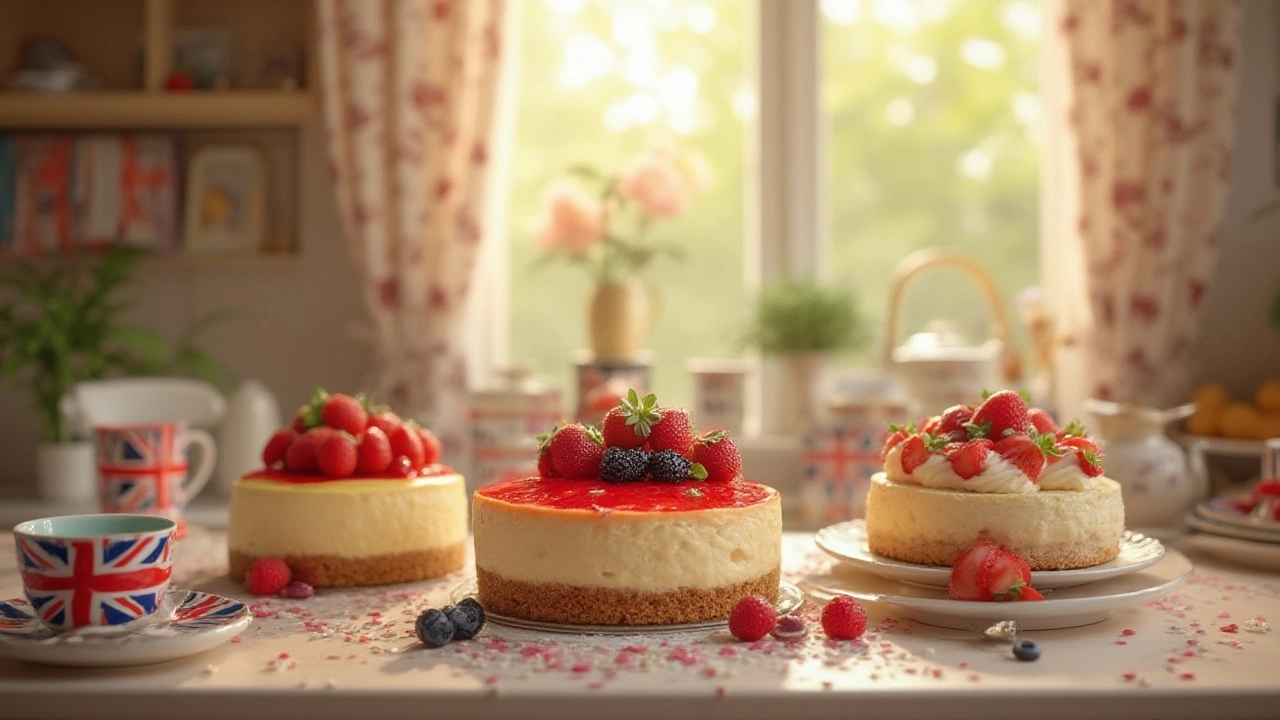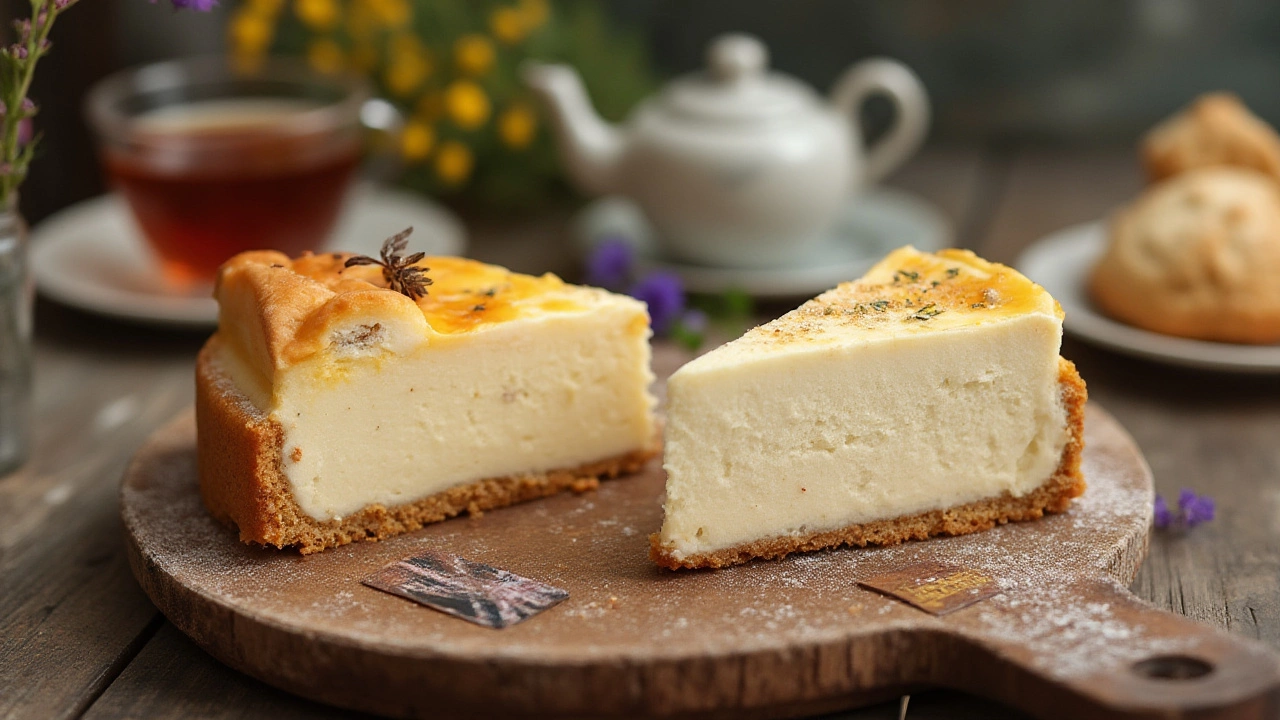
Imagine a fork cutting through a towering, creamy slice of classic New York cheesecake. Now imagine scooping a soft, mousse-like no bake cheesecake straight from a chilled pie pan. These two treats might share a name, but every bite shouts their differences. Oddly enough, plenty of folks can’t tell them apart, even though once you know the clues, you’ll spot the difference every time. If you’re ever torn on what to bring to a gathering or whip up for dessert, knowing exactly what sets these two apart is a culinary game changer. And, let’s be honest, knowing how each is made is a bit of a dessert superpower—especially when you learn their quirks, backstories, and fail-proof tricks for home kitchens.
The Classic New York Cheesecake: Baking, Richness, and Texture
Sink your teeth into a New York cheesecake, and you’ll instantly notice a richness that’s almost velvety. It’s the heavyweight of the cheesecake world—dense, smooth, and unapologetically creamy. This isn’t just by chance. The recipe leans heavily on blocks of full-fat cream cheese—sometimes as much as 2 pounds for a single 9-inch cake. In fact, commercial bakeries in New York are said to churn through over fifty tons of cream cheese every single week. No surprise New York cheesecake tastes so indulgent.
The magic starts by blending cream cheese with sugar, eggs (often five or more), a touch of vanilla, and something creamy—think heavy cream, sour cream, or even a bit of both. Sour cream is non-negotiable for many bakers; it gives the cake its signature tang and ensures that “just right” level of moistness. This mix lands atop a thick crust. Unlike its graham cracker cousins, New York cheesecake isn't shy about its crust. Some recipes call for extra brown sugar or finely ground cookies in the base.
Baking isn’t just a step—it’s a ritual. The batter goes into a springform pan and is usually baked in a water bath, or bain marie. This helps the cake cook slowly and gently, dodging unsightly cracks. Pro tip—wrap the pan tightly in foil so no water finds its way into the crust, unless you’re secretly into soggy bottoms. At around 325°F, the cake bakes for over an hour, then rests in the turned-off oven with the door cracked, gently settling. After that, it needs hours (often overnight) in the fridge to become perfectly sliceable. If you’ve ever tasted a slightly warm, unchilled cheesecake, you already know it isn’t the same dish at all.
What about toppings? Classic New York cheesecake almost always goes naked or with a scatter of fresh berries—no need for overpowering sauces. It’s about the cheese and the cream, not a sugar rush. There’s a reason legendary delis like Junior’s have been selling the same recipe for over 70 years: don’t mess with perfection. And if you want detail, here’s a calorie bomb for you—one standard slice can pack 600 calories, so maybe leave room for just a sliver or an extra walk. But hey, it’s worth it. If you want data, check out the table below comparing nutrition per slice against its no bake cousin.
| Type | Calories (per slice) | Main Ingredients | Bake Time |
|---|---|---|---|
| New York Cheesecake | 600 | Cream cheese, eggs, sugar, sour cream, heavy cream | 60-90 minutes |
| No Bake Cheesecake | 350 | Cream cheese, whipped topping, sugar, gelatin (optional) | 0 minutes (chilled, 4 hours+) |
No Bake Cheesecake: Simplicity, Freshness, and Versatility
No bake cheesecake feels like the chilled-out cousin of the New York cheesecake. It skips the drama of a water bath, turns off the oven, and lets the fridge do all the work. If you’re looking for instant(ish) dessert gratification or want something lighter for a summer day, this version shines.
Instead of eggs and a long bake, the filling usually comes together with cream cheese, sweetened condensed milk or sugar, and something to help it firm up. Some folks use whipped topping, which gives the filling its trademark airy, mousse-like bite. Others fold in softly whipped real cream for a more homemade flavor. Lemon juice or a hint of gelatin often sneaks in—not so much for taste but to help everything set into sliceable goodness. But here’s the truth: set time matters. Unless you want cheesecake soup, don’t rush the chilling. It really needs at least four hours, though overnight is better.
What about the crust? No bake cheesecakes almost always rock a simple press-in crust mixture—graham cracker crumbs mixed with melted butter and sometimes a spoonful of sugar or even a touch of salt. Since it isn’t baked, the crust stays more tender, almost sandy. Folks with a thing for chocolate or gingersnaps often crush those cookies for a twist. The beauty? Most no bake bases can be made gluten-free in a snap with oat or nut-based biscuits.
No bake cheesecakes love a good topping. They beg for piles of fresh fruit, swirls of berry sauce, or a spill of lemon curd. This isn’t accidental—no bake cheesecakes are milder, so toppings help seal the flavor deal. Maybe that’s why you see them everywhere at summer potlucks or family barbecues, especially when the oven already feels like a furnace.
And talk about speed. Some no bake cheesecakes can be made in as little as 20 minutes (not counting chill time), which is a lifesaver when you realize you forgot dessert duty. Cleanup is effortless. No water baths, no stuck-on edges, just a pan and a spatula. If you’ve got kids or new bakers in the house, this dessert is a friendly starting line for kitchen fun.

Ingredients & Technique Breakdown: What Makes Each Unique?
Ready to spot a cheesecake impostor at a glance? It all boils down to a few ingredients and what you do with them. First, let’s talk New York cheesecake. If your cheesecake contains eggs and requires actual time in the oven, it’s almost definitely a baked version. Eggs are essential—they give the filling its custard-like texture, extra structure, and that creamy bite. And don’t forget about the higher proportion of cream cheese; some New York-style recipes use more than twice the amount you’d find in a no bake.
Sour cream and sometimes heavy cream play key backup roles. Sour cream brightens the flavor and softens the heaviness. Heavy cream adds body, creating a filling that’s rich but never rubbery. For the crust, classic graham cracker reigns supreme in New York style, though a shortbread base is a close contender. Most serious recipes call for baking the crust separately for a few minutes before pouring in the filling—this keeps it crisp beneath all that creamy weight.
When it comes to no bake cheesecake, the list looks shorter and lighter: cream cheese, whipped topping or whipped cream, sugar, and often a helper ingredient for setting—gelatin or lemon juice (the acid helps firm it up). Without eggs, this type never thickens up the way a baked version does; it stays more mousse-like, light, and quick to melt at room temp. The crust is almost always a press-in, never baked, which means buttery, crumbly, and perfectly suited to quick chilling.
Technique might sound boring, but it’s the single biggest thing that sets the two apart. New York cheesecake is all about patience: slow mixing (to avoid beating in too much air), careful water baths, and the art of chilling overnight. It’s not hard, just fussy—a fair trade for that texture. No bake cheesecakes are made in a fraction of the time. Just whip, pour, and chill. There’s almost no way to mess it up unless you refuse to let the fridge work its magic. If you forget the gelatin or don’t chill it enough, you’ll end up with a sweet puddle; otherwise, you’re golden.
Which Cheesecake Should You Choose? Tips & Trivia
Trying to decide which cheesecake style deserves a spot at your family table or next party? Let’s break it down for different occasions and preferences, since there’s a right moment for each. Go for New York cheesecake when you want bold, classic, celebratory. Nothing feels quite as indulgent as cutting into that rich, tall wedge at a special dinner or impressing friends at a potluck. If someone in your family once lived in New York or you’re after a dessert with bragging rights, this is the one. For birthdays and holidays, the drama and flavor of a baked cheesecake just can’t be beat.
No bake cheesecakes are party lifesavers. Say you forgot to turn on the oven, or you’ve only got a half hour to pull something together. They taste lighter, and you can play around with all sorts of flavors and toppings—think tropical fruit, caramel, or even peanut butter swirls. These versions are usually safe bets in steamy kitchens or for picnics, since they’re a bit less dramatic but still crowd-pleasers. They’re also a little easier on your waistline, packing about 350 calories per slice compared to 600 in a New York original. Plus, vegan no bake cheesecakes are trendy for folks avoiding dairy or eggs, using blended nuts, coconut cream, or even silken tofu.
Whichever style you love, here are a few bulletproof tips:
- Room temperature ingredients make for smoother fillings in both versions—cold cream cheese gets lumpy.
- To avoid cracks in baked cheesecake, stop mixing as soon as everything comes together. Overbeating adds air, which causes cracks.
- Don’t skip the water bath for baked versions. If in a hurry, try placing a tray of hot water on the oven shelf below. It helps, even if it’s not quite the same.
- No bake versions LOVE time to set. Four hours is minimum, overnight is best.
- For clean slices, dip your knife in hot water and wipe between cuts. You’ll get bakery-style slices every time.
Cheesecake isn’t an everyday dessert. But honestly, it makes any day better—and now you know how to pick (and make!) the slice that fits your mood or occasion. If you crave sweets, experiment a little. Try swapping in lime juice, or layering on a tangy fruit compote, or even building mini versions in jars for a picnic treat. Cheesecake, no matter the style, is a comfort food legend—easy to love, fun to make, and ready to steal the show at any dessert table.